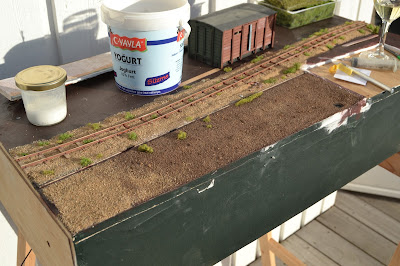Having tested the track on the factory module for a while with a variety of locos, I turned to painting track and sleepers. Rail and steel sleepers were given a coat of Humbrol 113 'Rust'. When dry some sleepers were painted with Vallejo 71.129 'Light Rust' to create a little variety. The top of the rails were then wiped clean. After a few days I gave rails and steel sleepers a wash of heavily diluted burnt sienna oil paint. The top of the rails were wiped clean again.
 |
| A length of steel sleepered track painted and weathered. |
The few wooden sleepers on the module were treated with an very thin mix of several oil paint; primarily black and burnt umber. After painting the track was left alone for a few days and then tested again. I wanted to make sure the track still worked flawlessly before starting ballasting.
It seems to me that modellers are divided as to when to ballast track: before landscaping or after. I like to have the track finished before gluing down grass, buildings and other scenic features, but after all the 'dirty work' with plaster and power tools. Ballasting on Nystrup Gravel is done with gravel. Surely no surprise there. The gravel company hadn't much money for track maintenance, but gravel was never in short supply. I am using sieved gravel from a bucket I acquired when the pavement was laid down around my old house. Before use the gravel is sieved through an old kitchen sieve.
 |
| Lumps of grass glued in the track. I use small pieces of grass mats from Heki. |
Tufts of grass are glued in the track before ballast is applied. Most industrial railways never fought grass and weed in the track and consequently a generous amount of vegetation shot up between the rails and sleepers. I also placed litter and garbage before I ballasted. I figured that the short part of the line passing between the brick wall and wooden fence would be a place where litter accumulated. I placed some old bricks (Preiser), an empty oil can (Plus Models), some rags and card board (home made from copper foil) and some empty bottles (Plus Models).
 |
| Grass and litter in place before ballasting. I have never tried to add litter along the line so I am curious to see the result when the ballast is in place. |
I sprinkle the sieved gravel over the track with a small spoon.
The ballast invariably getting stuck in the grass is removed by working the grass
tuft with a tooth pick (the glue used for the grass must be completely
dry by this time). I adjust the sprinkled ballast with a soft
brush, making sure rail and sleepers are free from ballast particles.
 |
| The dry ballast is now in place. The last pieces of ballast on sleeper tops and rail still needs to be removed with a soft brush. |
I use standard white PVA glue thinned with tap water to glue the ballast in place. I add a few drops of washing up soap to remove the surface tension of the liquid. The glue is applied with a standard syringe. Many articles mention that the ballast is wetted with water and and a few drops of washing up liquid, but I have always skipped that part and gone directly to application of glue. I have never had problems with glue penetration in the ballast.
 |
| After the glue has been applied the track needs to dry thoroughly before being worked on again. I apply the thinned white glue with the syringe in the foreground. |
Once the glue has fully dried I clean the track of loose gravel with a
vacuum cleaner. Then it's time to clean the rail heads again. I use a
soft cloth with acetone followed by a wipe with a Q-tip dipped in window
cleaning fluid.
 |
| The glue has dried and all that remains is some minor adjustment and a little air brushing. |
 |
| Ballasting done. The module progresses slowly. The end tipping skip is left on the track. |






















